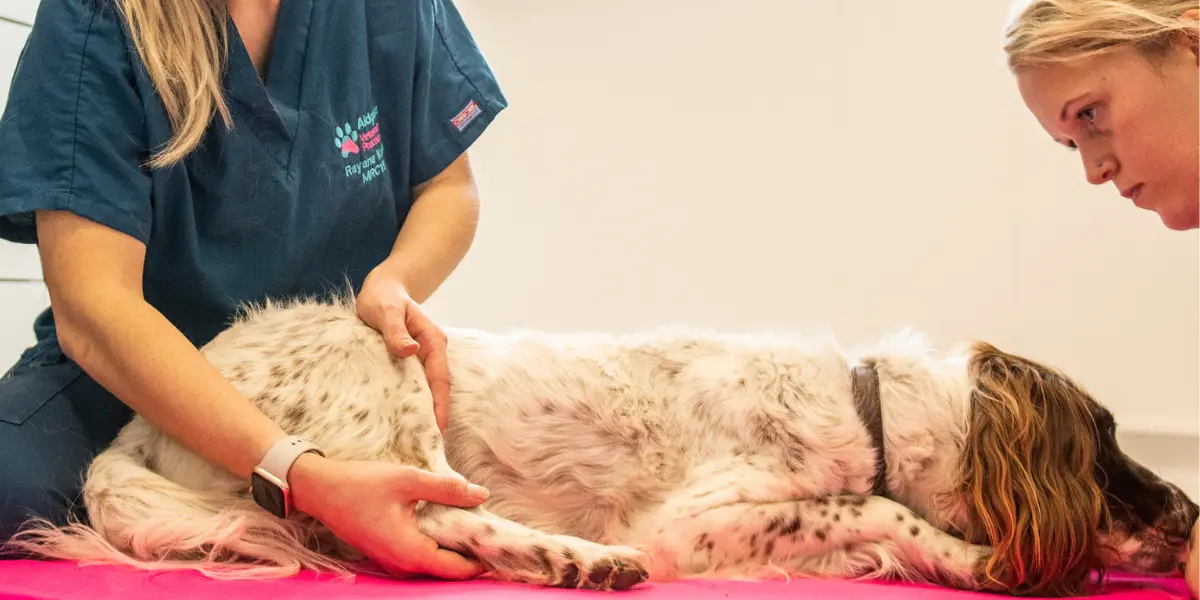As pet parents, we love giving our dogs a good scratch or cuddle, so it’s not unusual to stumble upon an unexpected bump or lump under their fur.
But how do you know when it’s something to worry about?
We regularly examine bumps and lumps on dogs, and while many are harmless, others can be more serious.
Knowing what to look out for and when to book a check can make all the difference to your dog’s health.
Common Types of Skin Growths on Dogs
Not all lumps and bumps on dogs are dangerous, but they should always be evaluated by a veterinarian.
Here are some of the most common types of lumps and bumps on dogs:
Lipomas (Fatty Tumours)
- Soft, round, and movable under the skin
- Typically benign
- Common in middle-aged and older dogs
- Can grow large and affect mobility
Sebaceous Cysts
- Small, round lumps filled with sebum (a greasy substance)
- May rupture and release a white or yellowish discharge
- Usually benign, but can become infected
Abscesses
- Pockets of pus under the skin caused by infection (often from bites or wounds)
- Usually red, swollen, and painful
- May burst and drain
Skin Tags
- Small, soft, skin-coloured growths
- Often found in older dogs
- Typically harmless and painless
Warts (Papillomas)
- Caused by a virus (especially in young or immunocompromised dogs)
- Look like small cauliflower-like growths
- Often appear around the mouth, eyes, or paws
Enlarged Lymph Nodes
- Firm, round swellings in typical lymph node areas (neck, behind knees, under arms)
- Can indicate infection, inflammation, or more serious conditions like lymphoma
Insect Bites or Stings
- Appear suddenly
- Often red, swollen, and itchy
- Usually resolve within a few days but can cause allergic reactions
Ticks
- Looks like small, dark lumps attached to the skin
- May enlarge as they feed
- Should be removed carefully to avoid leaving mouthparts behind
When to Be Concerned About a Lump
Some skin growths on dogs require prompt veterinary evaluation.
Watch for:
- Rapid growth
- Irregular or asymmetrical shape
- Firm or fixed in place
- Ulceration or bleeding
- Pain when touched
- Changes in colour or texture
Make sure you get in touch with our veterinary team if you’re unsure. Early detection can make a big difference, especially in cases of cancerous growths.

Why You Should Regularly Check for Lumps
Early detection is key. We recommend that pet owners get into the habit of performing gentle home body checks monthly:
- Run your hands over your dog’s entire body.
- Take note of any new or changing lumps.
- Keep a record of location, size, and consistency.
If you’re ever unsure, book an appointment, it’s always better to be safe.
Diagnostic Tools We Use at Aldgate Vets
When a lump is identified, we may recommend one or more diagnostic procedures to determine its nature:
Fine Needle Aspirate (FNA)
This is a quick, minimally invasive procedure where we extract cells from the lump using a small needle and examine them under a microscope. It helps determine if the growth is benign or malignant.
Biopsy
In some cases, we may need a small tissue sample (biopsy) for further analysis in a lab. This gives more definitive answers, especially for fast-growing or suspicious masses.

When to Book a Vet Check
If you notice any of the following, it’s time to visit us at Aldgate Vets:
- A new lump or bump on your dog
- Changes in size, colour, or texture
- Lumps that bleed or ooze
- Your dog seems uncomfortable or is licking/biting the area
Even if you suspect it’s just a lipoma, it’s important to get a professional opinion. We’re here to help.
Peace of Mind Starts with a Simple Check
Not all lumps on dogs are dangerous, but all should be checked. Whether it’s a harmless lipoma in dogs or something requiring treatment, we are here with the expertise and compassion your pet deserves.

Need to check a lump?
Your dog’s health is always worth it. Check any lumps or bumps, and if you’re unsure, book a visit with us today.





